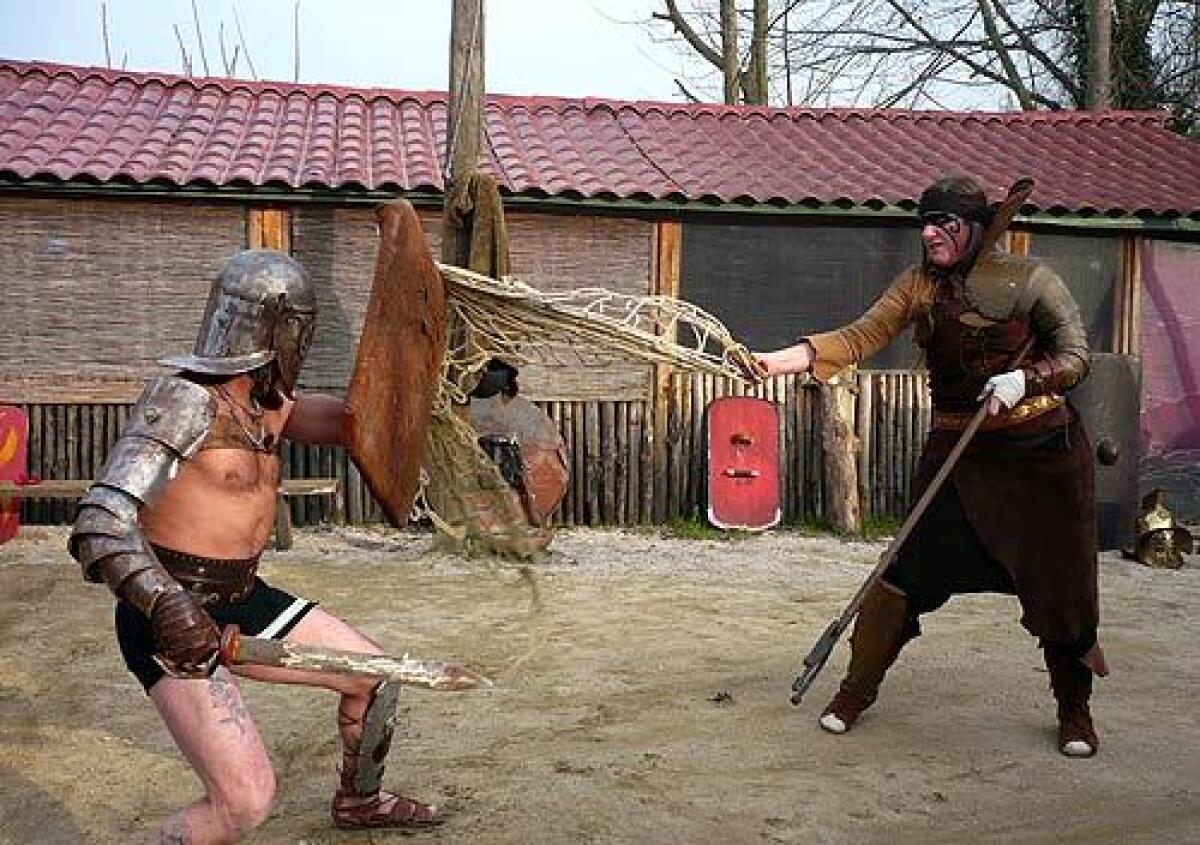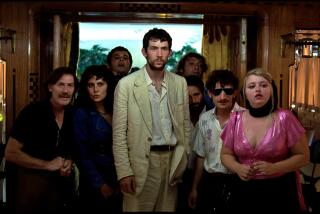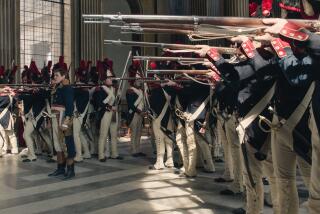Modern-day gladiators clash in Rome -- for fun

The gladiators charge each other with a great clashing and crashing of arms and armor. It’s hard to say who looks more fearsome: Atropo or Taurus.
Atropo, the towering Germanic barbarian, wears a mask of black war paint, a headband over her blond hair and a brown tunic and leggings. She wields a trident in one hand and whirls a net in the other.
Taurus, the compact Roman, is a tattooed mass of muscle beneath a battered metal helmet that covers all but his eyes. He circles behind his shield, lunging with the short sword known as the gladio.
The combat rages until Atropo snares the sword with her net, twists Taurus off balance and batters him to his knees. She whips a dagger from her boot and applies it to his jugular.
“Hah!” she snarls. “Now comes the moment when I cut your throat.”
In her conquering gaze, you can almost see a crowded amphitheater roaring in expectation, an emperor rising from his throne to proffer the gesture -- thumbs up? thumbs down? -- that will decide the fallen fighter’s fate.
Instead, a spatter of applause echoes in a workout room at the Sport and Fitness gym (English names are trendy here) in Ardeatina, an outlying neighborhood of Rome where middle-class Italians and concrete apartment blocks are more common than tourists and ruins.
Atropo helps Taurus pull off his helmet, and the two become 21st century Romans again: Giulia Mazzoli, a mosaic artist, and Michele D’Orazio, a construction worker.
Some people play Dungeons & Dragons in their spare time; some reenact battles; some learn martial arts. Mazzoli and D’Orazio have a pastime that combines elements of all three -- and a powerful dose of local pride.
They belong to a group of history buffs united by an obsession with ancient Rome, especially the gore and glory of the gladiator tradition. They immerse themselves in re-creating historic attire, tactics and weapons and honing their combat skills in a compound in the hills of the Appian Way that resembles the set of a low-budget swords-and-sandals movie.
Veteran students at the Rome Gladiator School see it as an all-consuming discipline that expresses the essence of their identity: citizens of the greatest capital in the history of civilization.
“I am a seventh-generation Roman,” D’Orazio says. “I am Roman in everything. I am from the Trastevere neighborhood. I grew up with the Colosseum, I saw it every day. I like ancient Rome. I learned about it through books, not films, because they are not authentic. I don’t like fakes.”
D’Orazio, 42, has a shaved head and a villainous goatee. He adorns himself with a menagerie: a wolf’s head necklace symbolizes loyalty, a lion figure on his helmet signifies pride, a bull tattooed on his chiseled torso alludes to strength and his fighting moniker. (“Because I am a bull.”)
His thuggish aspect softens when he recounts how he abandoned kendo, the Japanese sword-fighting art, after his wife discovered the gladiator school’s website five years ago.
“I like belonging to the group,” he says. “I like displaying myself in combat. I try to give the best of myself. I like the philosophy of kill or be killed.”
The blades are blunt, but the gladiators strive for the sound, feel and sweat of reality, with accompanying risks. D’Orazio’s nose -- describing it as Roman would be cliched but accurate -- had to be reconstructed after a shattering blow from a shield. His wife has become decidedly less enthusiastic about his hobby.
“Blood was pouring out of the eye holes of the helmet,” he recalls sheepishly. “A real blood bath.”
The school is part of the Historic Roman Group, whose members include air force generals, waitresses and butchers. On weekends, they impersonate archetypes of antiquity: The centurions drill, the belly dancers undulate, and so on. Every April 21, they are joined by foreign enthusiasts to celebrate the founding of Rome with a full-costume parade that passes the Circus Maximus and other landmarks. The group also provides courses for foreign visitors and tours the world giving demonstrations.
“We were in Shanghai for a show called ‘Roman Holiday,’ ” rasps Nero, the group’s founder. “It was a big hit with the Chinese.”
Nero, a.k.a. Sergio Iacomini, holds court at the club’s headquarters, a clammy, dingy warren of wooden buildings that used to be a bus barn. It houses cluttered offices, a small museum and sandy arenas for fighting.
With a touch of imperial swagger, Iacomini prowls the premises in green cargo pants armed with a busy cellphone (“Nero here”). The chunky, graying 56-year-old is both a grandfather and a new father. He shows off Popeye-size forearms developed during years of swordplay.
In his view, things have gone downhill since the days of the empire when battles were up-close and personal. “Now that was warfare. When the Romans fought Hannibal at Cannes, there were 25,000 men killed in four hours.”
Iacomini, a retired employee of the mint at the Bank of Italy, and a few friends created the club back in 1994. It has grown to several hundred members, who pay dues on a sliding scale for fighting classes in which they advance in skill ranks comparable to the belts of martial arts. Today there are about 17 gladiators, a hard-core minority drawn by the mix of physical and cultural activity.
Mazzoli, the blond mosaic artist, first joined a group of women who dressed up as Roman matrons, or upper-class housewives, but she soon defected.
“Being a matron was boring,” declares Mazzoli, one of two female gladiators. “This requires discipline, passion, responsibility.”
Like the others, the 34-year-old used museums, libraries and the Internet to create her alter ego, a barbarian combatant captured in the Germanic campaigns and brought to fight as a slave. She chose the name Atropo, one of the Three Fates of mythology, the sister who cut the thread of life when people died. Mazzoli has quite the kit of weapons, clothes and armor. Her outfit when she takes to the ring is realistic except for one detail.
“Back then I would have fought bare-breasted,” she said. “But I would risk arrest.”
In its quest to re-create the subculture, the group has not found a written set of gladiator rules. But texts and mosaics helped document details: Most gladiators fought barefoot. An umpire oversaw bouts. There was a lot of betting, and sometimes freemen went into the arena to pay off debts. Champions won wealth and renown comparable to modern-day boxers.
The evening sessions at the gym begin with basic conditioning exercises. The students line up for a ritual salute to the master gladiator, raising weapons and proclaiming, “Ave magister.”
The burly, goateed instructor is Carmelo Catanzaro, 42, who works at a company that manufactures neckties. He founded the group along with Iacomini and chose the moniker Spiculus, whom he described as a drinking buddy of the emperor Nero.
Catanzaro leads the class through drills and sparring. To prevent injuries, duelists stick to a defined repertoire of blows, do not feint, and choreograph the outlines of the exchange while leaving room for improvisation.
“There is a fine line between getting hurt and not getting hurt,” explained Catanzaro. He almost lost a toe to an overeager sparring partner’s sword thrust during a public exhibition.
With their pride in Roman authenticity, the gladiators might be expected to look down on the wannabes they encounter at events in other countries. But D’Orazio is open-minded: He sees them as proof of the empire’s enduring glory.
“I don’t have any problem with French or Hungarians or Romanians doing what we do,” he says. “I see them also as populations created by us. The Romans gave them everything: roads, aqueducts, the games. A lot of great gladiators were foreign slaves or prisoners of war. In that sense, we are all Romans.”
More to Read
Start your day right
Sign up for Essential California for news, features and recommendations from the L.A. Times and beyond in your inbox six days a week.
You may occasionally receive promotional content from the Los Angeles Times.






